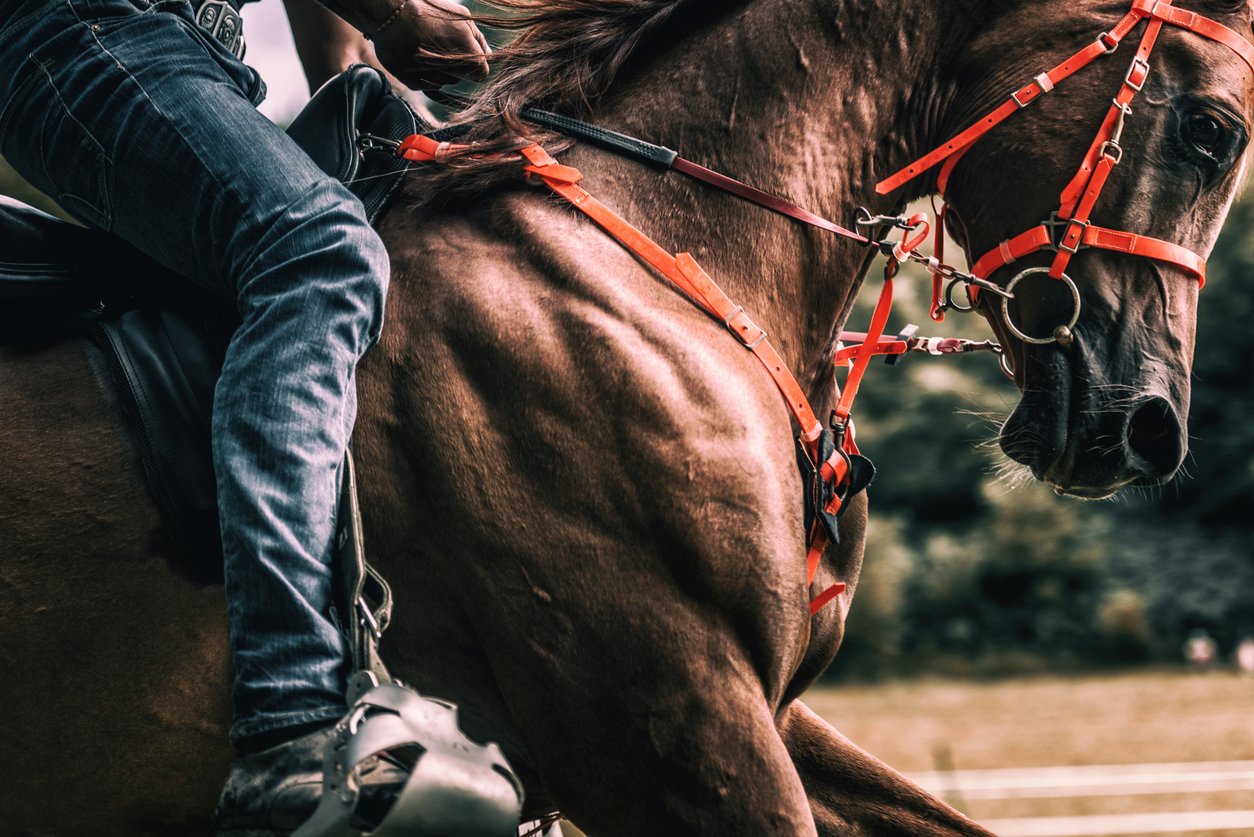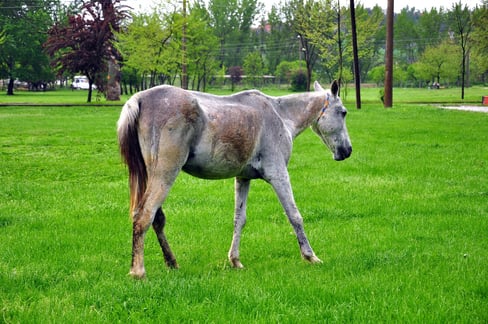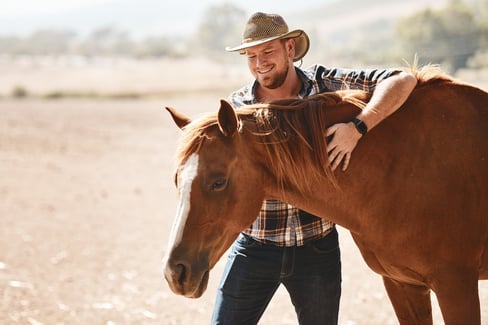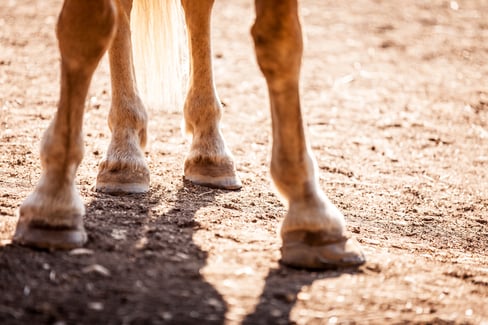Table of Contents
Without muscles, your horse wouldn’t be able to do, well, anything at all.
You couldn’t ride or compete with your horse.
And he couldn’t frolic in a field.
Healthy horse muscles reduce the likelihood of injuries and promote the overall health and longevity of your horse.
However, horses can be susceptible to a few unnerving muscle conditions that get in the way of their performance and day-to-day movement.
But don’t have a long face: we have some helpful info to share.
In this article, you’re going to learn everything you need to keep your horse’s muscles strong. We’ll discuss a variety of different muscle conditions and how to maintain muscle health for domestic and performance horses.
Ready?
Good! Because it’s time to stop stalling and get on with it.
Why Is Horse Muscles an Important Constituent of Equine Health
Muscles are tissues in your horse’s body that allow your horse to walk, gallop, jump, and canter. In essence, horse muscles are the foundation of all movement, so it’s key that you learn how to maintain animal muscle health if you want your horse to live his best life.
Unfortunately, horses can develop muscle diseases known as myopathies. There are many different types of myopathies, all with different causes, symptoms, and treatments.
And while we won’t dive into the details of all the types, we’ll cover a few especially common myopathies a bit later in this article.
Horse Muscles Anatomy (Domestic & Sport)
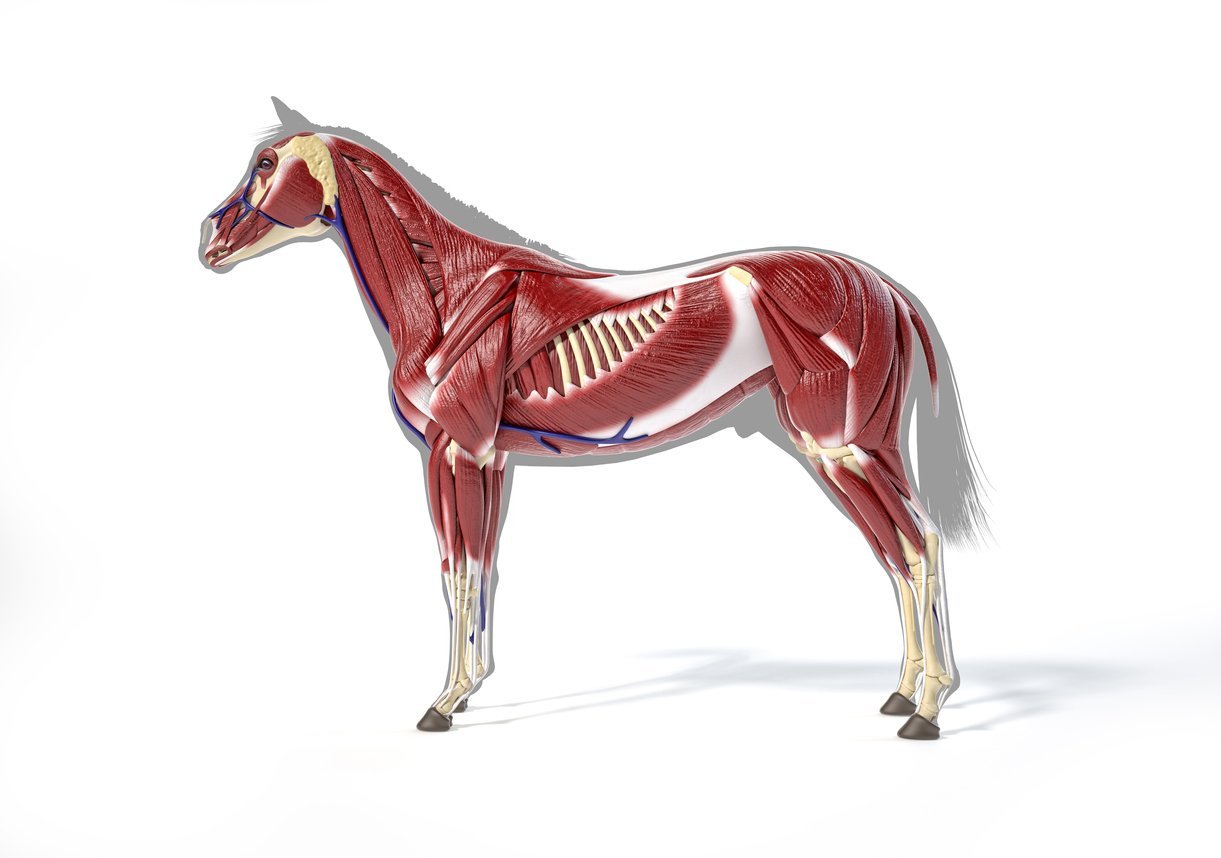
First, it’s time to take a quick trip back to high school science class. Let’s learn about horse muscle anatomy.
Horses have approximately 700 muscles in their body that facilitate movement of their limbs, as well as keep their hearts beating and blood moving.
There are three different types of muscles you should know about:
- Cardiac muscles: keep your horse’s heart beating.
- Skeletal muscles: attach to your horse’s bones and pull at tendons, allowing your horse to move.
- Smooth muscles: help facilitate involuntary processes in the body, such as blood moving throughout your horse’s circulatory system.
And while domestic and sport horses have the same muscles in their body, performance equine often have more enhanced muscle definition due to their high activity levels.
In particular, performance horses should have a well-developed topline. The topline consists of a horse’s neck, back, loin, and croup muscles and is key for proper balance and form while your horse jumps, pivots, and races.
Horse Muscle Structure
When it comes to your horse’s muscles, everything’s connected. Muscle movement results from a series of chain reactions. When one muscle contracts, another relaxes, which causes movement.
In addition to your horse’s muscles, tendons and ligaments are also key components of horse muscle structure.
- Tendons: connect muscle to bone.
- Ligaments: connect bone to bone.
Without tendons, your horse wouldn’t be able to move because there wouldn’t be anything linking your horse’s muscles to his bones!
Horse Muscle Diagram
The horse muscle diagram below shows some of the major muscles in your horse’s body, including the latissimus dorsi, which is the largest muscle. This muscle is where your saddle rests when you ride your horse.
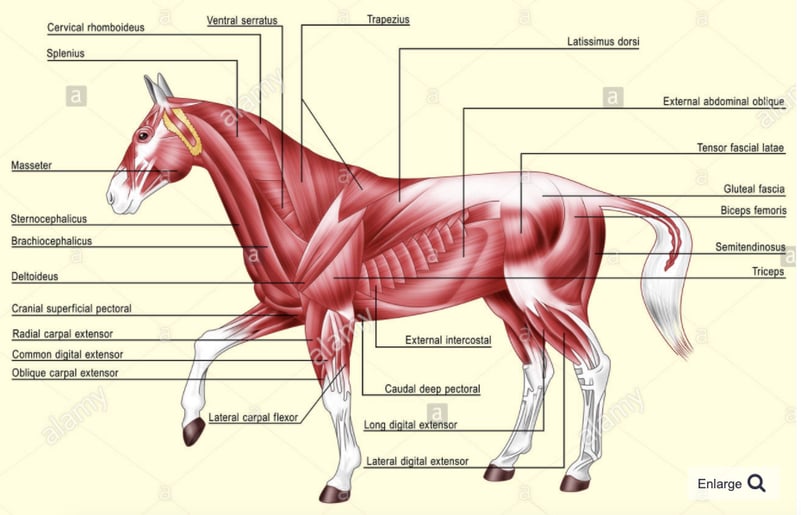
The diagram also shows your horse’s oblique muscles, which allow your horse to turn while you ride him.
How To Make a Horse Gain Weight and Muscle
If you want to know how to make a horse gain weight and muscle, the easiest way to evaluate muscle development is by assessing your horse’s topline. The top line is a horse muscle anatomy term that describes the coverage of the horse trapezius muscle, neck, back withers, loin, and coup. Horses with a muscular topline will be stronger and more athletic than those without one.
Protein is a natural horse muscle supplement and one of the best horse supplements for muscle gain. To develop strong horse muscle and help your horse gain weight, add high-protein feed and horse muscle supplements to their diet. When choosing a protein source, pick one with adequate crude protein and high in amino acids, specifically lysine.
Protein sources to build horse muscle include:
- Alfalfa
- Whey protein
- Soybean meal
- Milk protein
Horse Muscle Rub
Horse muscle rubs are soothing topical ointments, including horse muscle creams and horse muscle gels, designed to relieve the pain and stiffness of sore muscles. Look for a horse cream for muscle pain with a gel or cream-based formula containing horse supplements MSM, natural menthol, and essential oils.
MSM is a powerful horse joint supplement with anti-inflammatory and pain relief properties. In oral powder like TRI-ACTA for Equine, a comprehensive joint supplement, MSM is combined with glucosamine and chondroitin for horses to support optimal joint health and mobility and help soothe muscle-related ailments.
Horse Muscle Builder
Do you take protein powder or supplements like creatine and BCAAs after a tough workout? Horse muscle builders contain a highly-concentrated blend of equine supplements like gamma oryzanol and amino acids designed to help horses gain weight and lean muscle mass.
Horse muscle building supplements are designed to promote:
- Muscle development
- Recovery from exercise
- Muscle tissue physiology and performance
Implementing a horse muscle supplements is one of the best horse muscle growth tips for athletic horses and to maintain sport horse performance. Using a horse muscle builder supplement in conjunction with horse supplements containing glucosamine and chondroitin promotes joint mobility and flexibility. In addition, it will protect joint tissues as your horse’s body learns to accommodate new muscle and weight.
Horse Muscle Twitching Remedies
In most cases, horse muscle twitching and horse muscle spasms are caused due to a lack of fluids, poor nutrition, and improper exercise. More severe or chronic horse muscle twitching could be a type of equine myopathy, a skeletal muscle disorder. Injectable methocarbamol, IV fluids, and pain relievers can be used to treat horse muscle disorders.
You can try several natural horse muscle twitching remedies before considering anti-inflammatory medications, IV fluids, and pain relievers.
Natural horse muscle twitching remedies include:
- Increased water intake
- Electrolyte supplementation
- Magnesium, sodium, and calcium mineral supplements
- Increased potassium intake through hay or pasture
- Modified exercise routine
Horse Losing Weight and Muscle
Other than an old horse losing weight and muscle due to age, there are several reasons why your horse could be suffering from chronic weight and muscle loss.
The chart below provides an overview of the most common causes of a horse losing weight and muscle.
|
Cause |
Description |
|
Poor nutrition |
|
|
Health and disease issues |
|
|
Social interaction |
|
Muscular Ailments & Diseases in Domestic Horses
Now that we know a bit about your horse’s anatomy and muscle structure, it’s time to learn about the 3 most common muscular ailments and diseases in domestic horses.
- Horse Muscle Spasms
- Nutritional Deficiency
- Muscle Atrophy
Chomping at the bit? Keep reading.
1. Horse Muscle Spasms
Horse muscle spasms occur when your horse’s muscles suddenly contract without warning. Ouch.
These spasms can have several causes, including electrolyte imbalance, which is more likely to occur in hot or humid weather. Heat and dehydration may cause your horse to sweat out electrolytes (like potassium) that help keep him at his best.
So what’s an equestrian to do?
Provide your horse with a salt lick and plenty of water. This can help replenish lost electrolytes and make it less likely your horse will suffer from a muscle spasm.
Additionally, horse muscle spasms can be caused by an unbalanced canter. This is more common in domestic horses, as opposed to their performance horse counterparts, because they aren’t as experienced with using proper form.
In this case, practice makes perfect. Work with your horse to improve his balance and you may see a reduction in muscle spasms.
2. Nutritional Deficiency
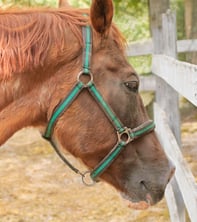
Nobody wants to be deficient.
And you don’t want your horse to be nutrient deficient.
Certain nutrients are especially vital for promoting your horse’s muscle health, like selenium and Vitamin E.
Unfortunately, around 30% of horses are deficient in selenium. A deficiency in this mineral can result in muscle aches and pains.
Other symptoms of a selenium deficiency are listed below:
- Dull coat
- Weak hooves
- Impaired movement
- Weakness
- If your horse is deficient in selenium, there are plenty of horse muscle supplements that can help him bring him back up to snuff.
But take care!
Too much of this mineral can be toxic for your horse. Consult with your vet to determine if a selenium supplement is right for your equine friend.
Amino acids are also important nutrients that promote muscle health. This is because amino acids are the building blocks of proteins, and proteins help build muscle.
Obviously, we don’t want your horse to be deficient in any of the building blocks of protein!
The chart below outlines some of the especially vital amino acids and provides details on what these amino acids do for your horse’s body.
| Amino Acid | What It Does |
| Lysine |
|
| Threonine |
|
| Methionine |
|
3. Muscle Atrophy
Everyone’s heard the phrase “use it or lose it” (and if you haven’t, now you have!).
Well, it applies to horse muscles too.
What are we referring to? Muscle atrophy.
It’s much easier to lose muscle than it is to gain it. Muscle atrophy is common in domestic horses or performance horses that have been “put out to pasture” after they become too old to compete. It also becomes more common as your horse begins to age.
Domesticated horses may have more difficulty staying fit since they aren’t as active. Over time, being inactive can cause a reduction in muscle tone.
And this doesn’t just affect your horse’s appearance. Losing muscle can make your horse more prone to getting injured.
The best way to reduce the amount of muscle atrophy that occurs is to make sure your horse is getting enough protein and the right balance of amino acids (such as lysine, which allows your horse to use the protein you feed him).
Muscular Ailments & Diseases in Sport Horses
It’s time to discuss myopathies, which is just a fancy word for any disorder that affects your horse’s muscle condition. These terms may sound complicated but don’t spook. We’re going to give it to you straight and simple.
1. Recurrent Exertional Rhabdomyolysis (RER) – Tying Up
Ever had a horse “tie up”?
He may have been suffering from a muscle disorder known as Recurrent Exertional Rhabdomyolysis (RER).
We’re just going to call it RER from here on out. Because that’s a mouthful.
RER leads to cramping and is especially common in horses that regularly over-exert themselves, such as sport horses in rigorous training. In fact, a study of 1000 horses during race season found that 33% of riders had a horse that “tied up” from RER.
That’s one in three horses, folks!
Some other symptoms of RER are listed below:
- Reluctant to move
- Sweating
- Heat and pain in infected muscles
RER is considered an emergency, so if you suspect your horse is suffering from this condition, call your equine vet immediately.
And it goes without saying that you’ll need to provide your horse with plenty of rest if your horse has this muscular disorder. So don’t ride him if you notice tying up!
Your vet may diagnose your horse using blood work, a muscle biopsy, or even genetic testing for a specific mutation of a gene that may cause RER.
2. Polysaccharide Storage Myopathy (PSSM)
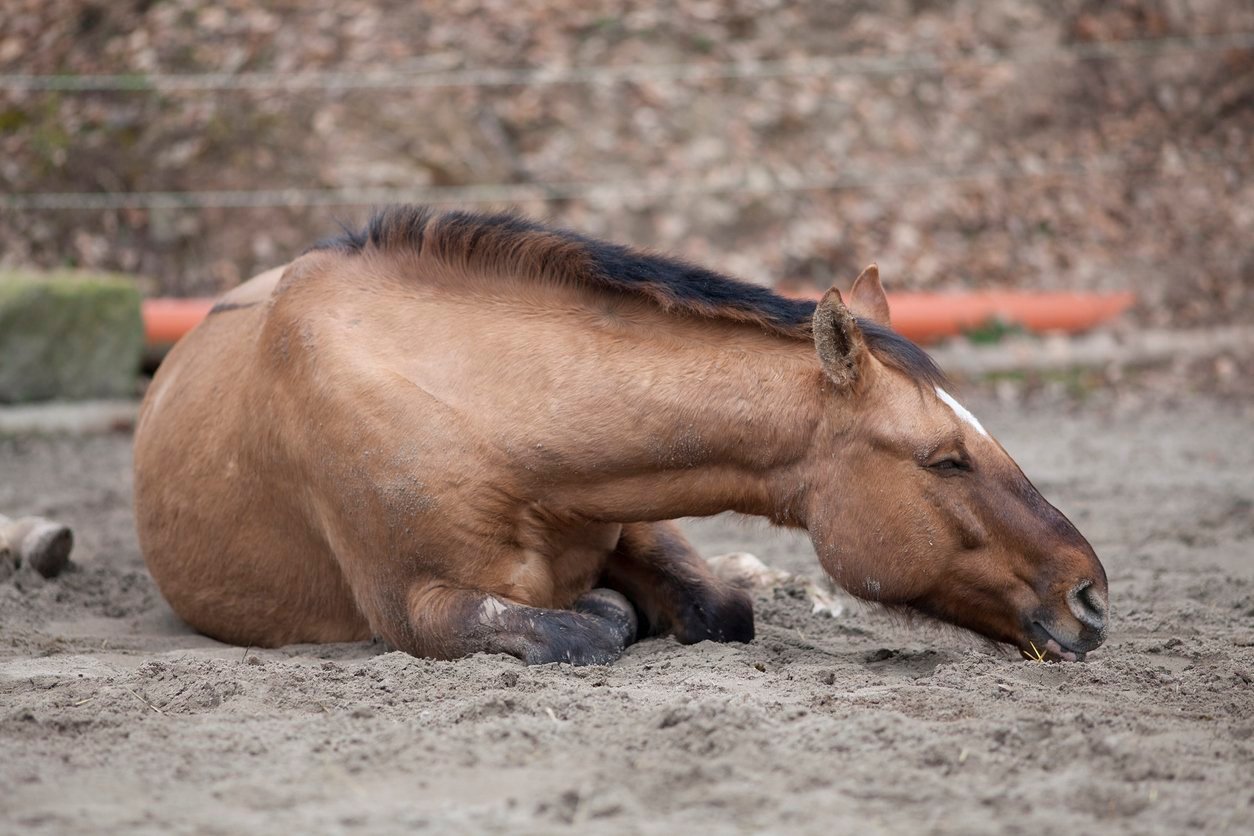
Though it pains us to say this, there is such a thing as too much sugar.
Polysaccharide Storage Myopathy (PSSM) occurs when your horse stores too much glycogen (sugar) in his muscle.
The symptoms of PSSM are below:
- Muscle stiffness
- Pain
- Muscle tremors (“tying up”)
- Lameness
- Sweating
There are two types of PSSM. One of these types is genetic, with PSSM being especially prevalent in quarter horses. The other type of PSSM still has an unknown cause.
If your horse is suffering from PSSM, there’s a somewhat easy treatment: diet change. Using low-carbohydrate forage can prevent too much glycogen storage in your horse’s muscles.
Many horses can improve their PSSM through diet, especially when exercise management (such as not riding your horse too hard) is also employed.
3. Hyperkalemic Periodic Paralysis (HYPP)
Want to learn about yet another difficult-to-pronounce muscle disorder?
You’re in luck. Next on our line-up is Hyperkalemic Periodic Paralysis (HYPP).
This muscle disorder is caused by your horse having too much potassium in his blood, which causes his muscles to contract more easily than they should. This leads to unpredictable muscle spasms and tremors.
HYPP is most common in horses that are especially muscled.
And we already know that performance horses fit that description.
Horses with HYPP don’t often appear to be in pain, which can make diagnosing this condition a bit trickier. As such, HYPP is often diagnosed with a gene test.
Unfortunately, this is one of the more serious myopathies on our list. HYPP can lead to paralysis and even death due to cardiac arrest.
As a result, treatment is often of the slow-and-steady type. Your vet may recommend you take your horse on short walks since he can suddenly become paralyzed.
Additionally, your vet may recommend a diet that’s low in potassium, such as feeding your horse alfalfa hay.
Tips on Maintaining Muscular Health in Domestic Horses
Now that you’ve learned about some of the common muscular disorders in domestic horses, we’re going to shift gears into something a bit more proactive: maintaining your horse’s muscular health.
1. Healthy Diet
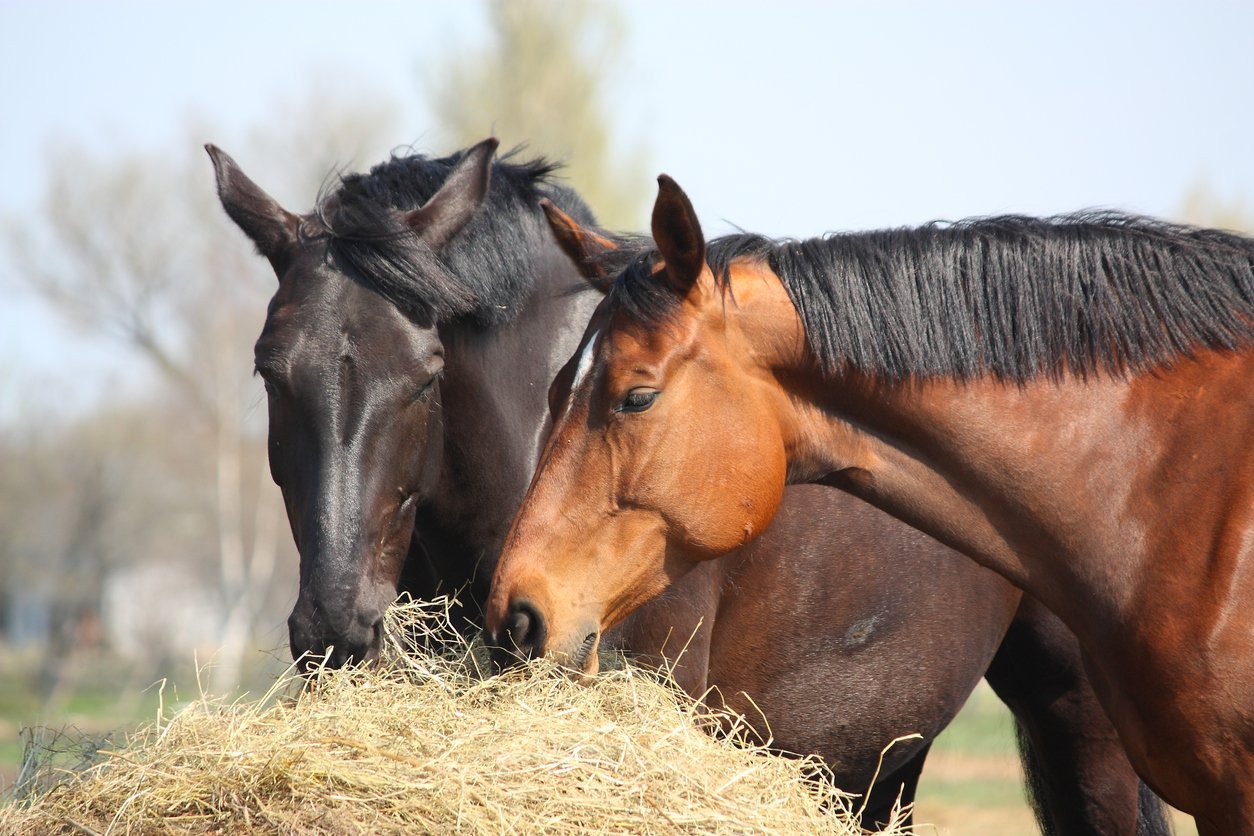
Healthy diet = healthy horse muscles.
It’s kind of a no-brainer.
In particular, providing your horse with access to fresh grass is a key part of a healthy diet. Eating fresh grass helps ensure that your horse is getting enough B vitamins. These vitamins promote red blood cell health so that your horse’s muscles can get enough oxygen.
And when your horse has enough oxygen, he has less of a chance of getting muscle cramps.
Win-win-win.
Additionally, grass provides your horse with much-needed Vitamin E, since your horse can’t synthesize this vitamin on his own. Vitamin E can help your horse’s muscles recover from stress during particularly active days.
Finally, providing your horse with a salt lick can prevent electrolyte imbalance, reducing the likelihood of those muscle spasms we discussed earlier. Similarly, making sure your horse is getting enough water can ensure proper electrolyte balance.
2. Horse Supplements
A healthy diet goes a long way to promoting horse muscle health.
But there’s even more you can do.
What’s that, you ask?
Horse muscle supplements.
If you aren’t sure whether your horse is getting enough B vitamins, Vitamin E, or selenium, a horse supplement may be the way to take your horse’s muscle health to the next level.
Additionally, ingredients found in joint supplements for horses, such as glucosamine, chondroitin, and MSM, can help promote healthy joints, tendons, and ligaments.
Do you know what that means?
Less risk of injury and more support for your horse’s muscles. In particular, glucosamine and chondroitin are great for keeping your horse’s cartilage healthy, as well as promoting healing in tendons and ligaments.
Integricare TRI-ACTA Equine is a great horse supplement option for domestic horses because it includes both glucosamine and chondroitin. The supplement also comes in powdered form, making it easy to add to your horse’s food.
TRI-ACTA for Equine
Providing preventative support for younger horses and helping mitigate the early onset of joint degeneration and other mobility issues.
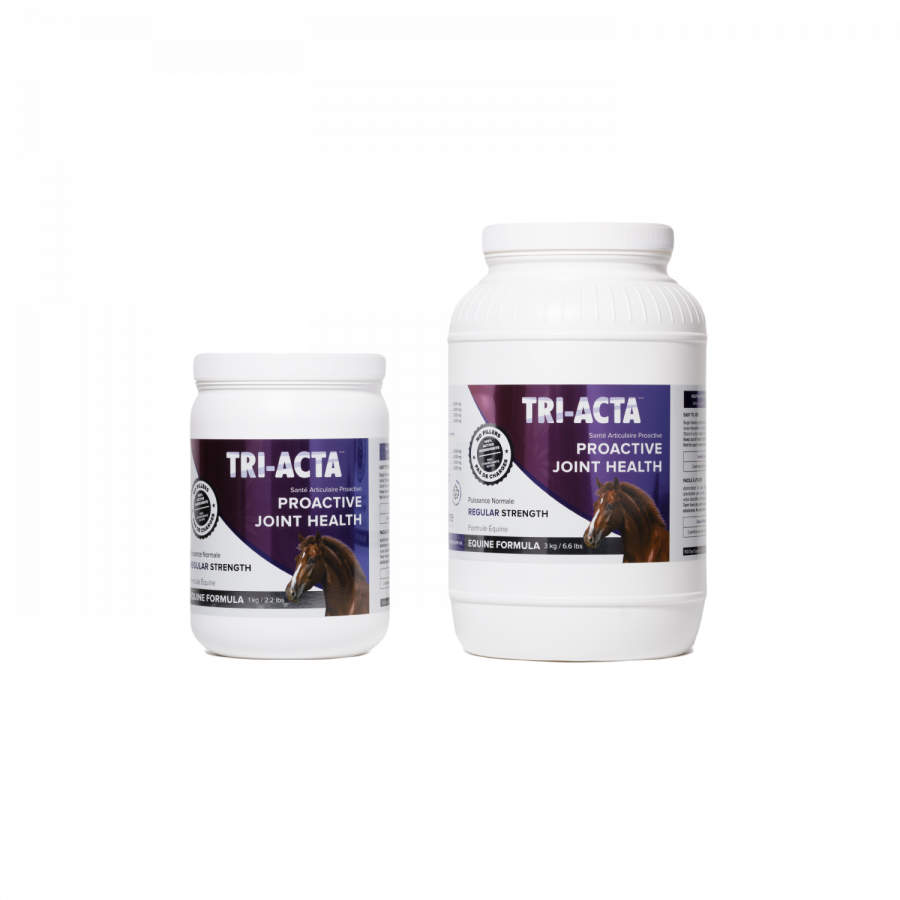
3. Regular Exercise
Even if your horse isn’t competing, he should still be getting plenty of exercise.
For a domestic horse, this could be as simple as taking him for walks or rides around your property.
Or if you’ve just got a bit too much on your plate at the moment to walk or ride your horse, let him wander in a field. This can be a great way for him to stay active while also getting some mental stimulation.
One of the worst things you can do for your horse is keep him in his stall 24/7! Your horse should use his muscles a little bit every day so they don’t begin to atrophy.
And it’s just as important to maintain equine mobility in winter months. Allow your horse to stretch and move around when it’s cold, even if it’s just for some grass-munching and meandering.
Tips on Maintaining Muscular Health in Sport Horses
We’re nearing the finish line on muscle health now. But don’t slow down. This stuff is important! In this section, we’re going to cover how to maintain muscle health in performance horses.
1. Adequate Warm-Up
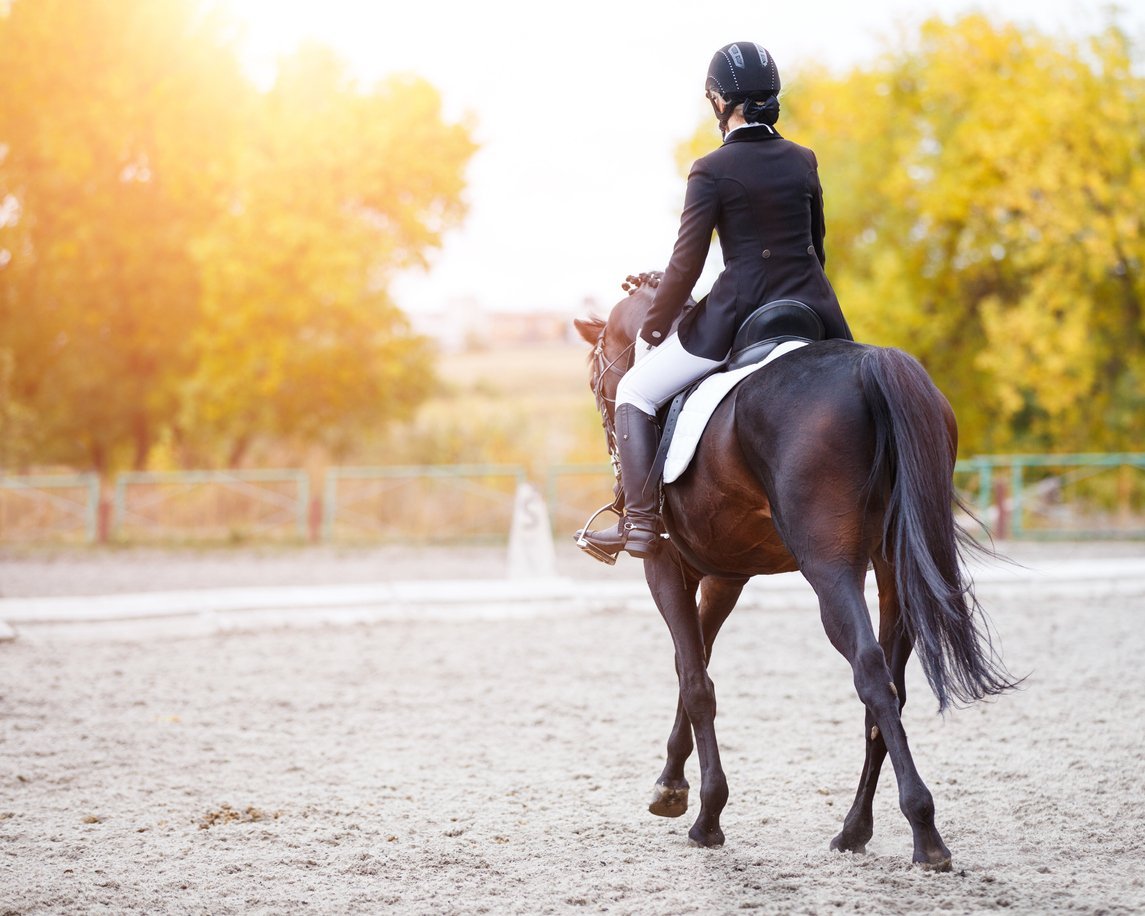
3-2-1… GO!
Actually, hold up a minute. You should probably make sure your horse is properly warmed up before doing any horse training.
If you don’t, you could stress your horse’s muscles out, leading to a myriad of muscle issues.
Before you dive into a canter, start by walking your horse for 10 minutes, then gradually move into a trot. As he begins to warm up, you can start introducing bends, like figure eights, to help loosen up his muscles.
And when it’s particularly cold outside? Spend a bit of extra time warming up. Your horse’s muscles are going to be stiffer than they would be in warmer weather.
2. Massage
You already know how relaxing a massage can be, so why not give your horse the same luxury?
Massages help reduce muscle pain and soreness if your horse has had a particularly rough workout, or if he’s suffering from a muscle disorder.
They also help increase circulation throughout your horse’s body, which means more oxygen is moving to your horse’s muscles. This helps speed up the healing process.
Some signs your horse might benefit from a massage are listed below:
- Unbalanced gait
- Slower than usual
- Spooks more easily than normal
- Hesitant to walk/move forward
You can learn to give your horse a massage yourself, or if you want to make sure he’s getting only the best (lucky guy), you can take him to a massage specialist.
3. Horse Supplements
We talked about horse supplements when discussing domestic horses.
But don’t be mistaken. Supplements can help take your performance horse to the next level too.
Horse supplements minimize muscle soreness and pain and promote overall horse health. In particular, joint supplements with active ingredients like MSM can help reduce inflammation and pain in your horse’s body.
And the link between horse muscles and joints is strong!
Joint pain in places like the sacroiliac joint (where the pelvis and spine meet) often occurs at the same time as musculoskeletal pain.
This means that by maintaining the health of your horse’s joints, tendons, and ligaments, you may help reduce the likelihood of comorbid issues that affect horse muscles.
The long and short of it is that joint supplements like TRI-ACTA H.A. for Equine help keep your horse’s muscles performing at max capacity.
Pretty cool, huh?
Top 3 Horse Muscle Supplements
1. Integricare TRI-ACTA for Equine and TRI-ACTA H.A. for Equine
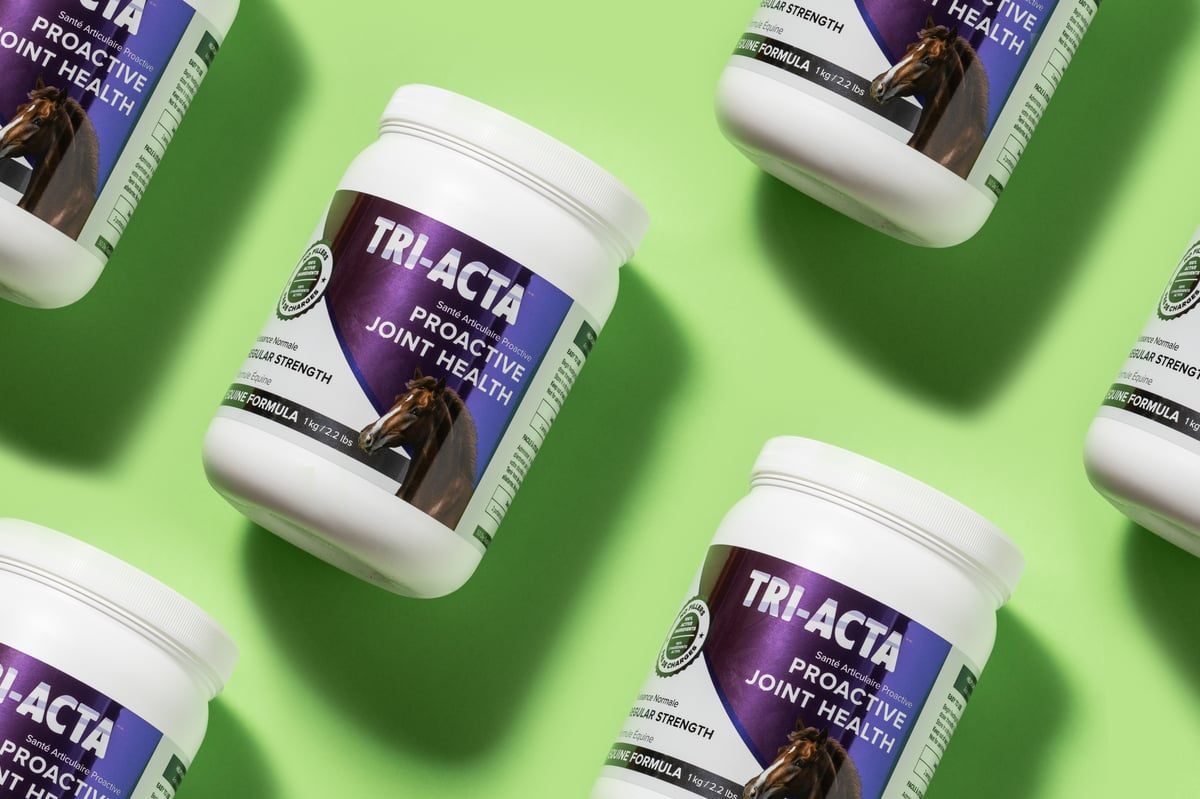
You’re getting this information straight from the horse’s mouth: Integricare TRI-ACTA Equine and TRI-ACTA H.A. Equine are great options for promoting joint and muscle health.
And we know we’ve technically put two supplements in the first place, but each of these supplements is so great, we just couldn’t choose between them.
Let’s discuss each so you can decide which one of these is right for your horse.
Both supplements contain the key active ingredients glucosamine and chondroitin, which help maintain cartilage (and prevent its deterioration). They also contain MSM, which can help with pain and inflammation.
The key difference?
TRI-ACTA H.A. is maximum strength (great for performance horses), and also includes the ingredient hyaluronic acid, which helps lubricate your horse’s joints.
We’ve outlined some more of the details below.
| Supplement | Characteristics |
| TRI-ACTA |
|
| TRI-ACTA H.A. |
|
TRI-ACTA H.A. for Equine
Our maximum strength formula is perfect for horses that are ageing, experiencing arthritis and stiffness, are in training and competition, or under a heavy workload.
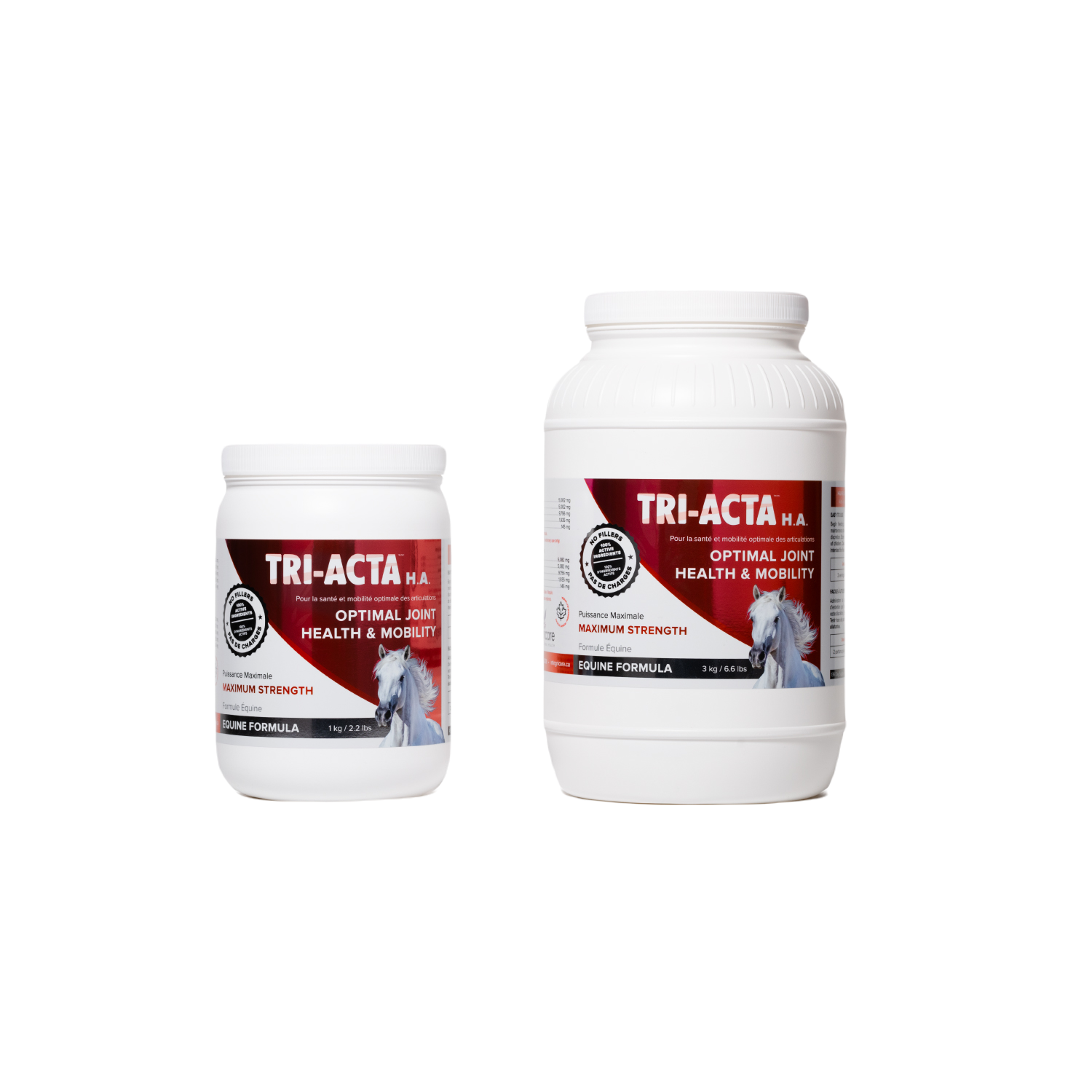
* Price for TRI-ACTA Equine: $89.99 to $259.99 CAD as of May 2023
* Price for TRI-ACTA H.A. Equine: $129.99 to $369.99 CAD as of May 2023
2. Ani-Motion Natural Botanical Blend
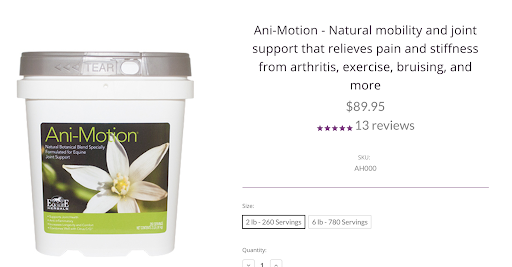
If you’re looking for a natural horse muscle supplement, Ani-Motion Natural Botanical Blend might be it.
This supplement can help reduce inflammation, stiffness, recovery time, and muscle pain. Talk about keeping your horse’s muscles working at peak performance!
Additionally, Vitamin C (from ingredients like rose hips) supports your horse’s connective tissues, such as tendons and ligaments.
Did you get all that? Because they really pack a punch in one supplement!
And to top it off, it’s affordable.
No wonder this supplement made second on our list.
* Price: $89.95 to $229.95 CAD as of May 2023
3. Kauffman’s Vitamin E and Selenium Pellets
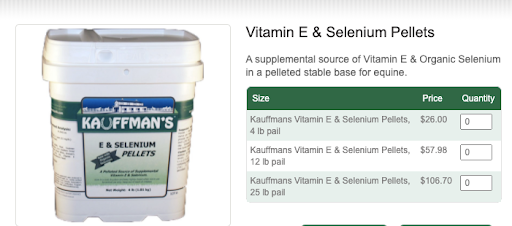
Last but certainly not least, Kauffman’s Vitamin E and Selenium Pellets are a great option if your horse is experiencing muscle spasms or suffering from muscle pain due to a selenium deficiency.
Having adequate levels of selenium helps promote muscle health and ensures your performance horse can excel throughout his training and competing.
The Vitamin E in this product promotes circulatory system health, so your horse’s muscles can get enough oxygen while they do the hard work of taking you and your horse to first place.
And if pellets aren’t your horse’s thing, this supplement also comes in powdered form.
Always remember to check with your vet before feeding your horse additional selenium, as too much of this mineral can be dangerous for horses.
* Price: $32 – $120 CAD as of May 2023.
Horse Muscle Spasms Causes
Horse muscle spasms is a painful condition where a muscle or group of muscles contracts forcefully and involuntarily. If left untreated, muscle spasms can lead to muscle imbalance, improper performance, and limited movements.
Common horse muscle spasms causes include:
- Dehydration
- Electrolyte imbalance
- Poor nutrition
- Excessive sweating
- Nerve injuries
- Neurological or muscle diseases
Ensuring your horse has enough water and proper nutrition can prevent muscle twitching and spasms. Adequate water intake will restore the fluids lost due to excess sweating. Feeding your horse hay or pasture that is rich in potassium and magnesium helps with electrolyte imbalances.
If you have addressed these causes and your horse still experiences horse muscle cramps, contact your veterinarian. They may diagnose an injury or other illness causing muscle spasms.
Common Horse Muscle FAQs
How Can I Help My Horse Gain Muscle?
The best way to help your horse gain muscle is to ensure he is receiving a healthy diet and regular exercise. In particular, pay attention to the types of amino acids your horse receives.
This is because certain amino acids, such as lysine, help with protein synthesis. Without enough lysine, your horse’s body can’t build more muscle, even if you are feeding him an ample amount of protein.
What is the Strongest Muscle in the Horse’s Body?
The strongest muscle in your horse’s body is the longissimus dorsi. This muscle is your horse’s back muscle, which stretches across the back of your horse where you place a saddle when you ride.
Speaking of saddles, be sure you have a proper-fitting one to maintain the health of this muscle. Your saddle should sit flat behind the scapula, not riding up toward the front of your horse’s back, nor tipping in the back.
What Should a Horse’s Topline Look Like?
Your horse’s topline should be clearly defined and well-muscled. No part of the topline should look sunken-in. You can use your hands to identify if any areas of the topline feel flat where they shouldn’t and you always want to be feeling primarily muscle, not fat, on your horse’s topline.
In Conclusion
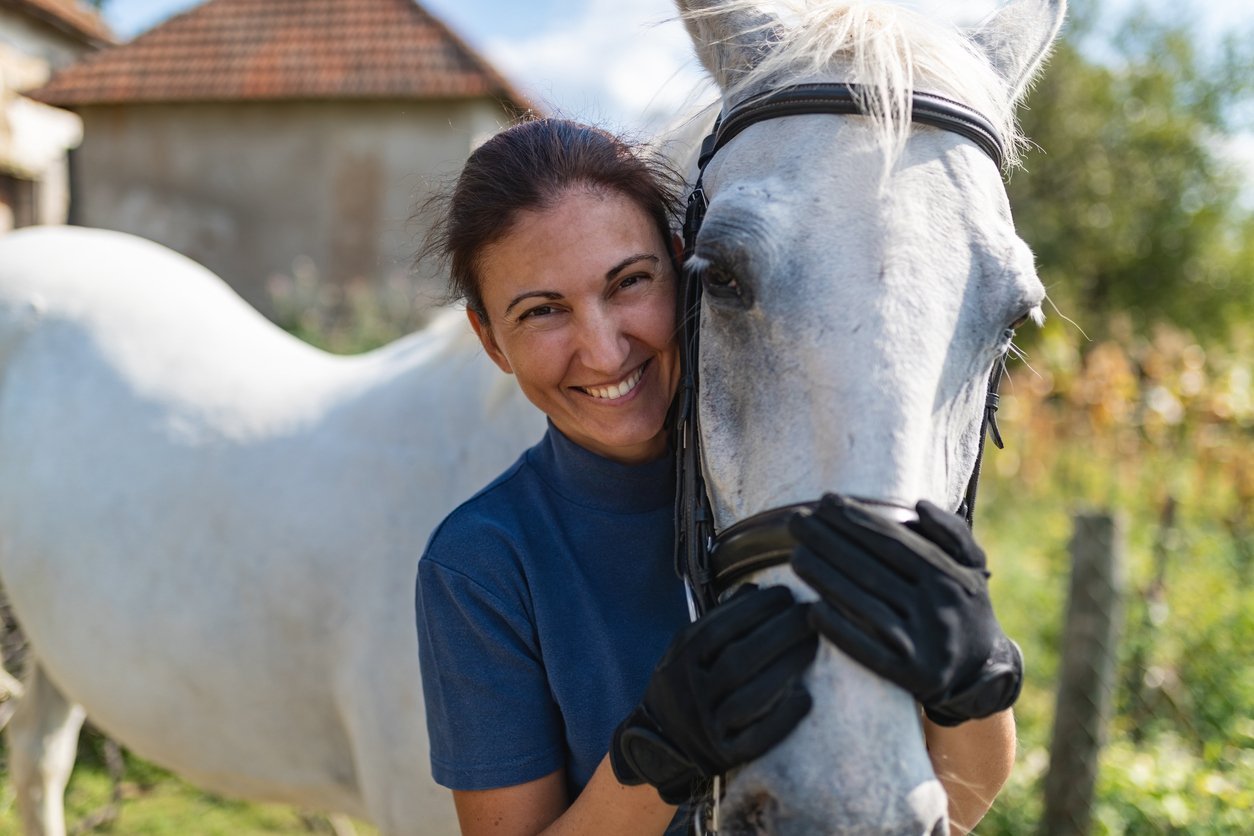
Your horse is relying on you to keep him healthy and fit.
That means ensuring his body has everything it needs to promote horse muscle health.
Whether your horse is a performance horse or a domestic horse, the basic tenets of a healthy diet and plenty of exercise go a long way to ensuring muscle health.
And if you want to take things up a notch, horse supplements like TRI-ACTA for Equine and TRI-ACTA H.A. for Equine are another great way to promote your horse’s muscle health.
TRI-ACTA H.A. for Equine
Our maximum strength formula is perfect for horses that are ageing, experiencing arthritis and stiffness, are in training and competition, or under a heavy workload.

Still itching for more information? Check out our blog.
Newsletter Signup
Subscribe to our newsletter to receive the latest news and exclusive offers.
.jpg?height=2000&name=Cliick_Integricare-DISPLAY-REVISEDV2%20(1).jpg)
Proactive & Therapeutic Joint Supplements
When given daily, Integricare joint supplements recover bone and joint injuries faster and help prevent mobility injuries from happening in the first place.

